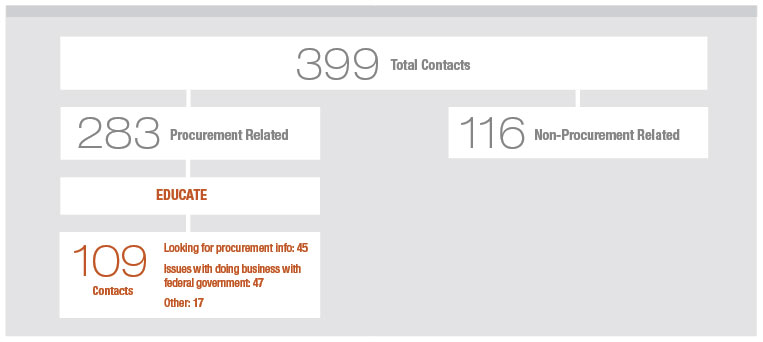Educate

Image description
This diagram builds on the previous diagram, illustrating that of the 283 procurement-related contacts, 109 were determined to fall within the Office's Educate pillar. This number is further divided into contacts looking for procurement information (45), issues doing business with the federal government (47), and other (17).
Raising awareness and sharing information
OPO regards its Educate pillar as a two-way street. On the one-hand, the 283 procurement-related contacts and information we gathered through our outreach events provide the Office with an invaluable source of procurement-related information, whichallows for the monitoring of issues and identification of trends and developments. On the other hand, it allows OPO to provide information to suppliers and federal organizations that can help respond toquestions or resolve issues.
What we did to respond to procurement questions and inquiries
Of the 283 procurement-related contacts, OPO addressed 109 by providing information and responding to questions. Many of these 109 contacts were from suppliers looking for information to betterunderstand the various procurement tools and processes used by federal organizations, whileothers raised concerns about doing business with federal organizations. In addition, some of the contactssought more details on the Office's mandate and services.
Whether responding to telephone calls, emails, letters, faxes, online comments, or through face-to-face meetings with suppliers or federal officials, OPO sought to provide useful information to individualsand organizations in a timely, professional and courteous manner.
What we did to raise awareness of procurement issues and exchange information
In addition to addressing contacts to the Office, OPO expanded regional outreach activities to reachmore small and medium businesses in Canada by hosting town hall-style meetings and informationsessions, attending conferences and tradeshows, and increasing our social media presence. These efforts provided another means for OPO to hear from suppliers about their experience with federal procurement and to inform them about our mandateand services.
Additionally, the Office met with federal organizations,the purpose being two-fold: first to inform federal organizations of the procurement issues suppliersare bringing to our attention, and second to learn from federal officials about the procurement-related challenges they face. Further, these meetings provided the Office with the opportunity toremind federal officials of the services we offer and how we can.
International interest
The Ombudsman was invited to speak at the GovProcure Conference in Sydney, Australia, illustrating a continued international interest in the fact that Canada has implemented an ombudsman specifically focused on procurement. At the Conference, the Procurement Ombudsman was able to learn about best procurement practices in other jurisdictions, and discuss alternative approaches being used internationally to resolve procurement concerns. Such international exchanges of information, in combination with domestic outreach events, are an important component in promoting improvements in the Canadian federal procurement system.
What we heard
The following are examples of what the Office heard from suppliers and federal officials during outreach events in 2015-2016:
Supplier feedback
- Cumbersome and burdensome solicitations, more specifically the amount of paperwork and time required to respond to solicitations, act as disincentives for suppliers.
- Short bidding periods make it difficult for suppliers to respond to the often extensive requirements in solicitations.
- Being required to provide costly samples, mock-ups or designs as part of bids is prohibitive, with some suppliers raising concerns these may be used by federal organizations to guide work that will be undertaken by competitors.
- Federal organizations are overly focused on lowest cost proposals, which may not provide best value.
- Communications barriers or challenges, including in obtaining debriefs from federal organizations on the shortcomings of unsuccessful bids after the award of contracts or concerns about a perceived lack of details provided through debriefs.
Feedback from federal officials
- Lack of capacity in some federal organizations, particularly in procurement, is challenging the ability of organizations to respond to demands and supplier inquiries.
- Centralizing procurement, within specific federal organizations or across federal organizations, may provide advantages as it would allow expertise to be located "in one place”.
Shared feedback
While suppliers and federal organizations highlighted different areas of concern, there were also areas where views were similar or complementary, which included:
- Delays in launching procurements, or lengthy procurement processes, are resulting in increased costs for suppliers and federal organizations.
- Challenges related to the security clearance process:
- Complexities associated with the process and length of time to obtain clearances;
- Challenges in obtaining sponsors; and
- Questions regarding requirements for finger printing and credit checks for certain types of clearances, and the potential impacts on timelines.
The more feedback the Office receives, the more we can help foster a greater understanding of procurement among all parties through the exchange of information. Where that does not prove to be enough, OPO will seek to facilitate the resolution of procurement issues. The following section outlines our activities under the Facilitate pillar.
- Date modified: